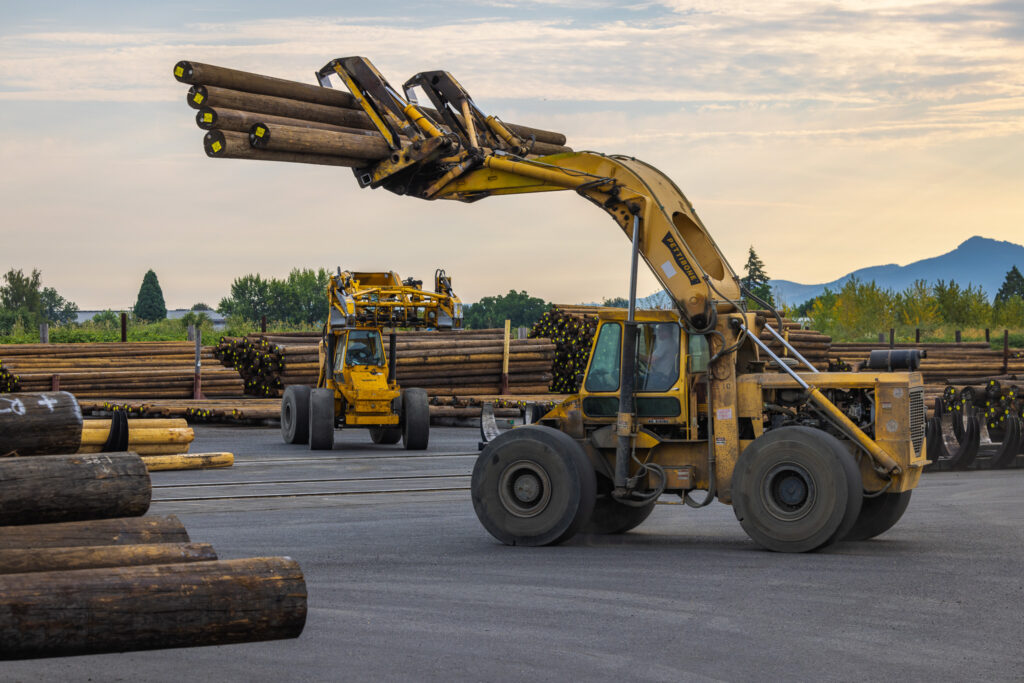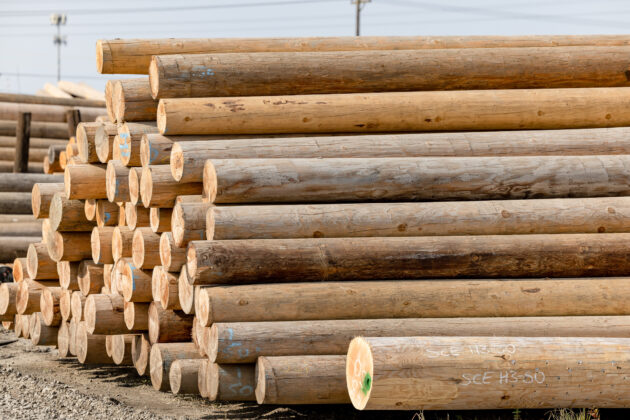
Features
Wood you know: Utility poles are a lasting legacy
February 3, 2023 By Natalie Tarini
 Wood utility poles continue to be a pillar in Canada’s electrical grid. Photo courtesy of Stella-Jones.
Wood utility poles continue to be a pillar in Canada’s electrical grid. Photo courtesy of Stella-Jones. Turning on a computer, calling someone to catch-up, adjusting the air or water temperature in our homes, these are all familiar tasks and yet, less is known about the one product that makes them possible, utility poles.
Approximately 150 million preserved wood utility poles deliver electricity and telecommunication services throughout North America. For over a century we have depended on wood utility poles for our day-to-day activities. While ubiquitous to our surroundings, few people who work outside of the utility or pressure treated wood industries understand the true impacts of utility poles on our lives and daily activities.
Thousands of Canadians work in the treated wood and utility industries. From the tree planters foresters, harvesters, treating facility employees, to the line workers who install and maintain the utility poles, the economic span of the wood utility industry is far reaching for Canadians from coast to coast.

Poles are typically made from four species of trees: Douglas fir, western red cedar, red pine and southern pine. Photo courtesy of Stella-Jones.
The history for wood utility poles is deeply rooted. The success of the telegraph wires led to the use of wood poles for wiring to distribute electricity to factories and homes. In 1908, standards for round timbers were developed and soon after, the American National Standards Institute (ANSI) adopted standards specifically for wood utility poles which defined the sizes and characteristics allowed. At that same time, standards for pressure treating wood with preservatives were developed through the Canadian Standards Association and the American Wood Protection Association.
Longevity and durability are essential requirements for utility poles. As a natural material, wood poles are exposed to outdoor elements and could face potential threats from predators such as mold, decay, fungi and insects such as termites and wood borers. These organisms seek to break down the wood fibre, reducing the structural integrity and serviceability of the pole. Pressure treating the poles creates a barrier that protects the wood from these threats, allowing them to remain in service for an extended period. To create the barrier, preservatives are penetrated into the sapwood making the wood less favourable to insects as well as providing long-lasting protection from mold or decay.
Poles are typically made from four species of trees: Douglas Fir, Western Red Cedar, Red Pine and Southern Pine. Trees that have the potential to become poles are selected in the forest and often while the trees are still standing. Forests are complex ecosystems that must be monitored and maintained. Canada is a global leader when it comes to sustainable forest management, with over 166 million hectares of certified forest. Trees are the only renewable building material and harvesting trees responsibly allows the ecosystem to regenerate. Adding preservatives to products such as utility poles extends their service life, allowing enough time to pass for a mature tree to grow in the forest.
John Shaw and Dana Shaw represent the fifth generation of the longest family-owned and operated tree harvesters in Canada, Herb Shaw & Sons Limited, located in Pembroke, Ont. Established in 1847, Herb Shaw & Sons has distinguished itself as a pioneer in the lumber manufacturing industry, producing top quality pine lumber and utility poles. Taking pride in Canada’s natural resource, the family established Shaw Woods, an outdoor education centre for students and nature trails for visitors in some of the finest old-growth forests in Eastern Canada. The Centre’s mission is to foster an ethic of responsible environmental stewardship while providing educational programs and self-directed learning for students, community groups, and the public at large. “Our family saw a need for more education around forest management, so we rolled-up our sleeves and created the Shaw Woods Outdoor Education Centre,” explains Dana Shaw. “With the help of our volunteers and generous donors, we’re able to offer a place for people to gather, learn about the importance of responsible harvesting for our ecosystem, connect with nature and find a new appreciation for forestry and the diverse jobs that depend on this natural resource.”
Did you know? A typical tree used in a utility pole application has sequestered an estimated 5,900 kg of carbon dioxide at the time of its harvest. That carbon dioxide stays trapped in the utility pole for the entire service life of the product and is not released back into the environment.
When the lights go out, the show must go on. We’re no stranger to natural disasters and the devastating impacts they can have on our infrastructure and telecommunications. Wildfires in B.C. ravaged communities, the storm in Ottawa left thousands without power for prolonged periods, and Hurricane Fiona devastated thousands of homes and businesses in Atlantic Canada. When these natural disasters occur, the only industry that can respond to the quantity demands for utility poles for electrical restorative efforts, is the wood industry. Considered an essential service throughout the pandemic, utilities and the treated wood industry work tirelessly to ensure the least amount of disruption as possible for homeowners during storms and natural disasters. “Having access to reliable supplies of utility poles that can be delivered quickly is especially important during restoration efforts when customers need power restored as quickly as possible,” explained Brenda MacDonald, Chair Treated Wood Task Group, Electricity Canada.
Wood utility poles continue to be a pillar in Canada’s electrical grid, transmitting and distributing electricity to hospitals, schools, homes and businesses across the country. But we also need to acknowledge the people behind the power. From the tree harvesters and wood treatment facilities, to the selection/preparation/installation and maintenance processes, thousands of dedicated employees work to ensure Canadians have electricity today as well as during restoration efforts. To you, we extend a heartfelt ‘thank you’ for all of your efforts in the past, present and future.
Learn more about wood utility poles at woodpreservation.ca and woodpoles.org.
Natalie Tarini is the executive director of Wood Preservation Canada, the industry association that represents the treated wood industry in Canada. WPC operates under Federal Charter and serves as a forum for those concerned with all phases of the pressure treated wood industry, including research, production, handling and use and the environment.
Print this page